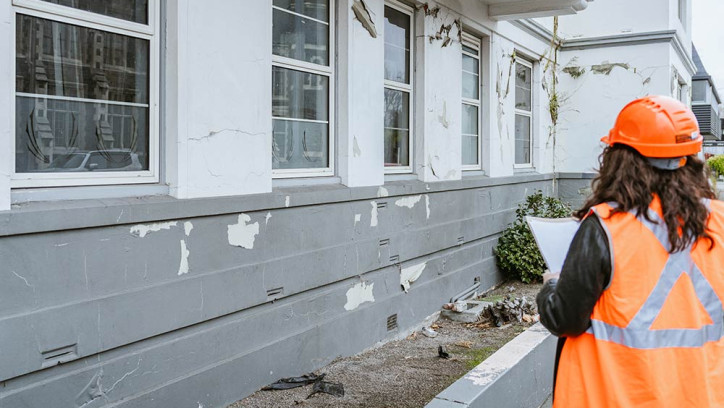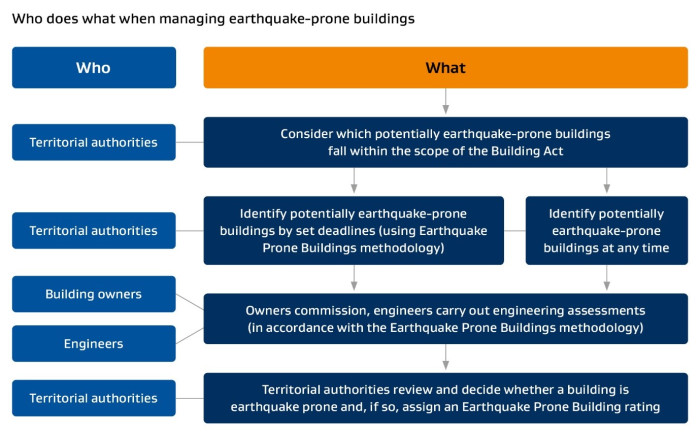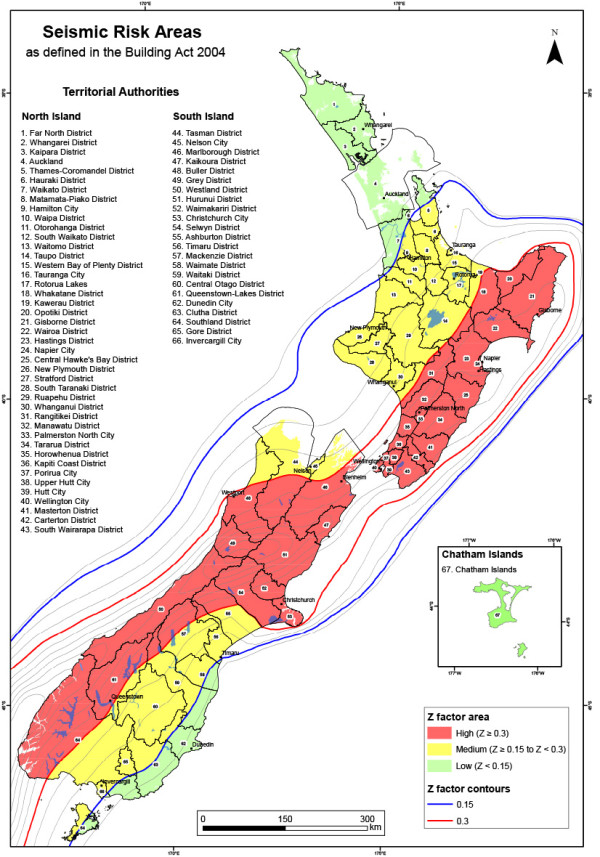How the earthquake-prone building system works

The earthquake-prone building system enables us to identify and manage buildings and parts of the building that present the greatest risk to public safety or other property.
The earthquake-prone building system is a national system introduced by the Building (Earthquake-prone Buildings) Amendment Act 2016 that regulates how seismic risk is identified and remediated in the most vulnerable existing buildings.
To mitigate the risk to life safety in a moderate earthquake, the earthquake-prone building system mandates that:
- territorial authorities identify potentially earthquake-prone buildings
- owners who are notified that their building is potentially earthquake-prone obtain engineering assessments of the building carried out by suitably qualified engineers
- territorial authorities determine whether buildings are earthquake-prone, assign ratings, issue notices, and publish information about the buildings in a public register
- owners display notices on their building regarding its status as earthquake-prone and remediate the building within specified timeframes.
The earthquake-prone building system provides consistency for the way buildings are identified and managed for future earthquakes, and considers a balance between the following:
- protecting people from harm in an earthquake
- the costs of strengthening or removing buildings
- the impact on Aotearoa New Zealand's built heritage
- the practicality and related timeframes of managing earthquake-prone buildings
- the emergency response.
The national earthquake-prone building system describes the following steps and includes the different key roles and responsibilities:
- How a potential earthquake-prone building will be identified based on its location. This focuses on the role of the territorial authorities.
- What to do when a building is identified as potentially earthquake-prone. This focuses on the building owners who are notified by their territorial authority and how the building owner must obtain an engineering assessment of the building carried out by suitably qualified engineers.
- The territorial authorities' role is to determine whether buildings are earthquake-prone based on the engineering assessment, assign ratings, issue notices, and publish information about the buildings in a public register.
- Building owners are required to display notices on their building and to remediate their building.
Earthquake-prone building and seismic risk management review
The Government has announced an extensive review of the management of seismic risk in existing buildings. The purpose of the review is to ensure seismic risk in existing buildings is being managed effectively and in a workable, proportionate way.
Earthquake-prone building and seismic risk management review - mbie.govt.nz
Risk areas
The Building Act 2004 divides Aotearoa New Zealand into three seismic risk areas – high, medium and low. These seismic risk areas are used to set time frames for identifying and taking action to strengthen or remove earthquake-prone buildings.
These risk areas are defined using the Z factor, which is the seismic hazard factor for each area of Aotearoa New Zealand. The Z factor is used when designing new buildings to comply with the Building Code.
| Seismic risk area | Z factor | Example locations |
|---|---|---|
| High | Z ≥ 0.3 | Gisborne, Napier, Hastings, Palmerston North, Wellington, Blenheim, Christchurch |
| Medium | 0.15 ≤ Z < 0.3 | Tauranga, Hamilton, Rotorua, New Plymouth, Whanganui, Nelson, Timaru, Invercargill |
| Low | Z < 0.15 | Northland, Auckland, Oamaru, Dunedin |
Table 1 Seismic risk areas and the Z factor - example locations
There is also a category of 'priority buildings' in high and medium seismic risk areas. These are buildings that are considered higher risk because of their construction, type, use or location. Priority buildings must be identified in a shorter timeframe than non-priority buildings. Owners are given a shorter time in which to carry out work on priority buildings.
The below overview shows a map of the seismic risk areas in Aotearoa New Zealand (indicative only).
Download the map of seismic risk areas [PDF 1.1MB]
To determine the Z value for each location, refer to this resource Z-values to determine seismic risk.
Time frames
Each seismic risk area has different timeframes for action, as seen in Table 2.
| Seismic risk area | Territorial authority must identify potential earthquake-prone buildings by | Owners of earthquake-prone buildings must carry out seismic work within (time from issue of earthquake-prone buildings notice) | ||
|---|---|---|---|---|
| Priority | Other | Priority | Other | |
| High | 1 January 2020 | 1 July 2022 | 7.5 years | 15 years |
| Medium | 1 July 2022 | 1 July 2027 | 12.5 years | 25 years |
| Low | N/A | 1 July 2032 | N/A | 35 years |
Table 2 Timeframes for action
Note:
The government have agreed to provide extensions for all current earthquake-prone building remediation deadlines while a comprehensive review of the system is underway. All non-lapsed earthquake-prone building remediation deadlines as at 2 April 2024 will be extended by four years. There will also be an option for the Minister for Building and Construction to extend remediation deadlines by up to two years, if required.
Regulations for buildings and parts of buildings
The national system focuses on the most vulnerable buildings, in terms of public safety.
The earthquake-prone building regulations apply to non-residential buildings and some larger residential buildings – those that are at least two storeys and either:
- contain three or more household units, or
- are used as a hostel, boarding house, or other specialised accommodation.
Some buildings are specifically excluded, including farm buildings, retaining walls, fences, certain monuments, wharves, bridges, tunnels and storage tanks.
Farm buildings
Farm buildings are specifically excluded because of the expected low consequence of failure of these types of buildings.
Farm buildings are those buildings, on farms, that are primarily used for farming activities or an ancillary purpose.
Examples of the types of buildings that can be considered as farm buildings are:
- stables
- wool sheds
- cow sheds
- hay barns
- herd homes
- implement sheds
- milking sheds
- fattening units
- ancillary buildings, and
- storage buildings.
Buildings on farms that are more similar to industrial or manufacturing type facilities should not be considered as farm buildings, for example:
- manufacturing plants
- packhouses, and
- vineyards.
However, as these facilities are generally modern buildings, they are unlikely to be earthquake prone.
Parts of buildings
Engineers assessing potentially earthquake-prone buildings need to consider vulnerable parts of buildings, as well as the overall performance of the whole building.
A part is an individual building element such as an unreinforced masonry parapet, which would pose a life safety hazard if it fell or caused another building element to fall during a moderate earthquake.
The methodology to identify earthquake-prone buildings sets out how engineers are required to consider and report on parts of buildings when undertaking an engineering assessment.
Roles and responsibilities
Territorial authorities, engineers and buildings owners have key responsibilities for managing earthquake-prone buildings. This is outlined in the diagram below.

